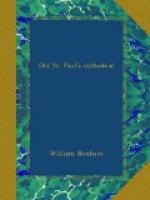[Footnote 1: On the site of this old tower, Archbishop Kilwardby afterwards built the house of the Dominicans, or “Black Friars.”]
[Footnote 2: Hence old Fuller’s racy witticism: “S. Paul’s is truly the mother church, having one babe in her body, S. Faith, and another in her arms, S. Gregory.”]
[Footnote 3: A pommel was a ball made of metal, from Lat., pomum: “an apple.” It was not uncommon to surmount church spires with hollow vessels and to take note of their capability of holding. Sometimes they were made in form of a ship, especially near ports where corn was imported.]
* * * * *
[Illustration: OLD ST. PAUL’S, FROM THE SOUTH. After W. Hollar.]
[Illustration: OLD ST. PAUL’S, FROM THE NORTH. After W. Hollar.]
[Illustration: OLD ST. PAUL’S, FROM THE EAST. After W. Hollar.]
[Illustration: OLD ST. PAUL’S, FROM THE WEST. After W. Hollar.]
CHAPTER II.
THE PRECINCTS.
The Cathedral Wall, its Course and Gates—Characteristic Names—The North Cloister—The Library—Pardon Churchyard —Minor Canons’ College—Paul’s Cross—Bishop’s House —Lollards’ Tower_—Doctors Commons—The Cloister and Chapter House—The West Front.
A wall was built round the churchyard in 1109, but was greatly strengthened in 1285. The churchyard had got such a bad character for robberies, fornications, even murders, that the Dean and Chapter requested King Edward I. to allow them to heighten this wall, with fitting gates and posterns, to be opened every morning and closed at night. From the north-east corner of Ave Maria Lane, it went east along Paternoster Row, to the end of Old Change, then south to Carter Lane, thence northwards to Creed Lane, with Ave Maria Lane on the other side. It will of course be remembered that the Fleet River ran along at the bottom of the hill, not bearing the best character in the world for savouriness even then, but crowded with boats as far as Holborn. It will be remembered that there was also a gate in the City Wall, on Ludgate Hill, a little to the west of St. Martin’s Church.




